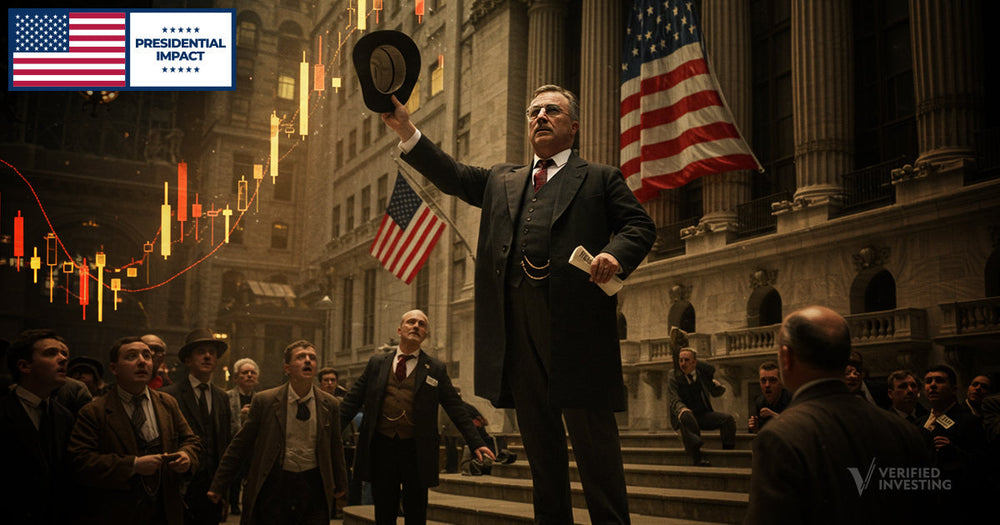Theodore Roosevelt: Trust-Busting, Reform, and the Market’s Progressive Era

Prologue: The Sudden Rise of a Rough Rider
It’s 1901. The sun sets over Buffalo, New York, casting long shadows across the Pan-American Exposition. News crackles through telegraph lines: President William McKinley has been shot by an anarchist named Leon Czolgosz. Suddenly, Theodore “Teddy” Roosevelt—at just 42—is thrust into the presidency, becoming the youngest U.S. president in history. While the nation reels from McKinley’s assassination, Wall Street eyes this dynamic, bull-charging figure with both curiosity and apprehension.
Teddy Roosevelt, known for his Rough Rider exploits in the Spanish-American War and his unrelenting energy, steps into the White House during a period of immense industrial expansion. Titans of finance—J.P. Morgan, John D. Rockefeller, and others—dominate railroads, oil, and steel. Powerful trusts hold sway over entire industries, shaping supply, prices, and competition. The stock market soars on speculation fueled by these corporate behemoths’ staggering profits.
What no one fully anticipates is how Roosevelt’s progressive beliefs—his deep distrust of unchecked monopolies, his conviction that government must protect the “public good”—will collide headlong with the era’s entrenched wealth. Over the next eight years, Roosevelt’s interventions and “trust-busting” crusade will redefine the relationship between markets and federal power. For modern investors and students of history alike, Teddy Roosevelt’s presidency marks a pivotal chapter in the evolving saga of American finance.
1. The Financial World Roosevelt Inherited
1.1 The Economic Landscape Roosevelt Inherits
After the Civil War, the United States entered a period often called the Gilded Age—an epoch of dramatic industrial expansion, surging rail networks, colossal fortunes, and severe inequality. Banking and corporate empires sprang up. The stock market, now more mature than in Lincoln’s day, had grown to accommodate shares of railroads, steel mills, and emerging “combinations” that consolidated multiple companies into mighty trusts.
By 1901:
- Steel: Andrew Carnegie’s steel empire, soon sold to J.P. Morgan and formed into U.S. Steel, boasted capital so large it could sway entire regions’ economies.
- Oil: Rockefeller’s Standard Oil controlled roughly 90% of refined oil flows, with near-dictatorial power in setting prices.
- Railroads: The backbone of commerce, with figures like E.H. Harriman and James J. Hill forging transcontinental routes. Railroad stocks dominated the New York Stock Exchange in both volume and speculative fervor.
In this environment, trusts inflated share prices to dizzying heights. Investors clamored for a piece of the “inevitable” profits churned by near-monopolistic corporations. Critics argued that consumer choice vanished in the face of these juggernauts, while pro-trust voices lauded “efficiency” and “progress.” So, as Roosevelt assumes the presidency, America’s financial barons expect little pushback—after all, government had traditionally taken a hands-off approach. But Teddy Roosevelt sees it differently.
1.2 Roosevelt’s Progressive Ideals
Roosevelt, a Republican in name but a progressive at heart, holds a vision of government as a mediator between corporate power and the public interest. He does not despise wealth per se—he admires entrepreneurial vigor—but he rejects predatory monopolies that crush competition. For him, the moral litmus test is whether businesses serve the common welfare or strangle it. This notion, radical to some Gilded Age magnates, will define his approach in taming Wall Street’s giants.
2. The Northern Securities Case: Declaring War on Monopolies
2.1 J.P. Morgan’s Colossal Railroad Trust
In 1901, days after Roosevelt’s ascension, J.P. Morgan, James J. Hill, and E.H. Harriman orchestrated the formation of Northern Securities Company to control the Great Northern and Northern Pacific rail networks. This super-trust threatened to monopolize transportation across the Northwest, effectively deciding freight rates, routes, and market entry. At stake was not just convenience, but the entire notion of free competition in a crucial segment of America’s infrastructure.
The stock market, initially, cheered the consolidation: “One giant trust is less chaotic than multiple rail lines competing.” Shares in these railroads soared on hype of guaranteed profits. Then the unexpected happened: President Roosevelt, brandishing the Sherman Antitrust Act of 1890, took legal action to dissolve Northern Securities.
2.2 Shockwaves on Wall Street
When news of the suit broke in 1902, Wall Street reeled. Investors feared the new president would systematically dismantle monopolies, potentially draining the inflated “trust premium” from many corporate shares. Some major industrial stocks dipped in response. Confusion reigned over whether the Northern Securities suit was a one-off demonstration or the start of a broader crackdown.
Roosevelt’s public statements accentuated the drama. He declared he did not oppose big business per se, but believed strongly in regulating “bad trusts.” The line between good and bad, however, was murky. J.P. Morgan, legendary for steering markets during panics, found himself blindsided by a federal government apparently no longer content to let private deals go unquestioned. For the stock exchange, it was the first real taste of a new era in which the White House might intervene in corporate affairs.
Outcome: In 1904, the Supreme Court ruled in Roosevelt’s favor, dissolving Northern Securities. This victory sent a clear signal: The era of unstoppable corporate consolidation faced a formidable adversary in the Oval Office.
3. Roosevelt’s Antitrust Policies and Market Regulation

3.1 Antitrust as Market Stabilizer?
Roosevelt’s administration soon launched suits against several other major trusts—beef, oil, tobacco—inciting more waves of fear among investors who had banked on the security of monopolistic returns. Ironically, in the longer run, these suits may have reassured some segments of Wall Street by affirming that the playing field would remain somewhat competitive. Smaller firms, overshadowed by giants, found fresh opportunities to raise capital, boost shares, and carve out market niches.
At the same time, Roosevelt’s measured approach—he did not kill every trust, only reined in the “bad” ones—helped avert a wholesale meltdown of investor confidence. He framed it as protecting capitalism from its own excesses, a perspective that echoes in modern times whenever government steps in to curb too-big-to-fail institutions.
3.2 The Bureau of Corporations and Regulatory Data
In 1903, Roosevelt championed the Bureau of Corporations within the Department of Commerce and Labor. This bureau gained authority to investigate interstate corporations, gather data on their business practices, and publish findings. Markets gleaned critical insights from these investigations. Some stocks soared once they were deemed free of antitrust troubles, while others dipped if the bureau’s reports hinted at questionable deals.
This early form of government-led corporate transparency improved the environment for rational investing. Instead of rumor-based panic, shareholders could sometimes reference official bureau data. Though the stock market was still nowhere near as data-driven as modern markets, these incremental steps toward disclosure foreshadowed future securities regulations.
4. The Panic of 1907 and Roosevelt’s Role
4.1 Overextension, Speculation, and a Financial Tumble
Despite Roosevelt’s attempts to moderate corporate excesses, speculation remained rampant in certain corners of Wall Street. By 1907, a feverish wave of mania inflated stock values, especially in mines, railroad expansions, and new industrials. Commodities and real estate joined the speculative party, with leveraged bets fueling short-lived booms.
When a scheme to corner the stock of United Copper failed spectacularly, panic spread as banks and trust companies associated with the conspirators faced runs. The crisis spiraled: depositors demanded gold, forcing banks to call in loans, which in turn hammered the stock exchange as people rushed to liquidate shares to cover margin calls. Stock prices plummeted, erasing fortunes in days.
4.2 Roosevelt’s Role (or Blame?)
Critics labeled it the “Roosevelt Panic,” alleging that his antitrust crusades and rhetorical lashings of big business had eroded market confidence. He fired back that unscrupulous financiers, not White House policies, lay at the root of the meltdown. Yet the evidence is mixed: while trust-busting may have introduced uncertainty for large corporations, the direct trigger of 1907 involved specific manipulations, questionable bank practices, and a general lack of a robust central bank to steady the ship.
Enter J.P. Morgan again: As in prior crises, Morgan personally intervened—gathering top bankers in his library, orchestrating liquidity injections, and forging rescue deals. The economy eventually stabilized, but it became glaringly obvious that the U.S. needed systemic solutions to prevent repeated panics. Roosevelt’s administration recognized the point, leading to discussions about more comprehensive banking laws—a step that would eventually lead to the Federal Reserve in 1913 under President Woodrow Wilson, but catalyzed by events unfolding during Roosevelt’s watch.
5. Labor Unrest, Coal Strikes, and Market Confidence

5.1 Anthracite Coal Strike of 1902
While not a direct stock market matter, Roosevelt’s handling of the 1902 coal strike illuminates how presidential actions can shift investor sentiment. When Pennsylvania coal miners walked out, threatening winter heating supply, share prices in coal railroads and related industries wobbled. Wall Street braced for a possible crisis if essential resources went short.
In an unprecedented move, Roosevelt invited union leaders and mine operators to the White House, effectively brokering a resolution. This signaled to investors that the federal government would intervene to avert disruptions of key commodities, relieving market jitters. The settlement’s success, while not boosting stock prices to new highs, reassured capital that a progressive president could still be pragmatic in stabilizing fundamentals crucial to economic health.
5.2 Setting a Precedent for Government Involvement
From an investor’s viewpoint, if Teddy Roosevelt was willing to step in and broker labor disputes, what else might he do? This question cut both ways. Some saw it as a sign that government would not allow total meltdown, fostering a backstop effect. Others worried about creeping “socialistic” policies that might impose price controls or hamper corporate autonomy. These contradictory sentiments fueled speculation and caution alike—bedfellows that remain intrinsic to stock market psychology even now.
6. Conservation Initiatives and Resource Industries
While Teddy Roosevelt is famed for trust-busting, he also championed conservation, establishing national forests, parks, and wildlife refuges. At first glance, preserving Yellowstone or the Grand Canyon might not relate directly to share prices, yet it symbolized a broader shift: the government felt authorized to regulate big logging or mining interests on public land. This signaled an evolving stance that environmental resources were not merely open for unbridled corporate exploitation. Some resource stocks, reliant on cheap access to public lands, found this new activism less than welcome. Yet, ironically, regulated resource management sometimes led to more sustainable, predictable returns over the long haul.
7. Market State and Perceptions at Roosevelt’s Exit
By the time Roosevelt left office in 1909, the stage was set for further financial regulation under subsequent administrations. His presidency had shaken the assumption that gargantuan trusts could simply shape markets unchecked. Yet it had also showcased the market’s resilience. Despite the 1907 panic and ongoing antitrust suits, the overall trajectory of industrial growth continued upward, fueling an eventual boom in manufacturing, rail expansions, and consumer goods.
7.1 Investor Perception: The “Square Deal” Legacy
Roosevelt’s “Square Deal” mantra—promising fairness to workers, consumers, and business—resonated in the markets in nuanced ways:
- Short-Term Tension: Each new antitrust action triggered near-term volatility as targeted stocks plummeted on fear of forced breakups or reorganizations.
- Long-Term Confidence: By removing the more abusive monopolies, Roosevelt arguably prevented deeper systemic issues. Over time, many mid-tier companies thrived, fueling a diversification of shares and an overall broadening of the investor base.
When Roosevelt departed the White House, the stock exchange was stronger, ironically, for having weathered the disruptions of both the trust-busting era and the Panic of 1907. Investors grudgingly adapted to the notion that government oversight was here to stay.
8. Roosevelt’s Impact Versus Previous Presidents
- Washington laid the bedrock of centralized finance; Roosevelt actively reined in private powers that threatened market fairness.
- Jackson fought a war against the central bank; Roosevelt waged war against unregulated corporate trusts, albeit for different reasons.
- Lincoln used federal might to unify and fund a war; Roosevelt leveraged federal might to ensure no private entity could dominate entire industries at the expense of the public.
Each presidency shifted markets in new ways. Roosevelt’s innovation was the concept that the federal government could shape market outcomes to ensure “fair competition,” possibly averting the bigger catastrophes that unbridled monopolies might cause. This stance set a precedent for future expansions of regulatory frameworks (like the Clayton Antitrust Act in 1914 and beyond).
9. Key Takeaways for Modern Investors
- Regulation vs. Market Freedom: Roosevelt’s era highlights the delicate balance between letting corporations thrive and reining in their excesses. Investors today see echoes in big tech antitrust suits or financial regulations post-2008.
- Short-Term Turmoil, Long-Term Stability: Trust-busting unsettled short-term stock prices, but some historians argue it prevented monstrous corporate abuses that might have led to sharper crashes.
- Crisis Management: The Panic of 1907 demonstrated the importance of swift, cohesive responses—an early forerunner to the more structured bailouts or liquidity facilities we see in modern crises.
- Presidential Influence: Roosevelt’s fiery rhetoric shaped investor psychology. The occupant of the White House can indeed move markets by their stance on regulation, labor disputes, or broader policy.
10. Conclusion: The Strenuous Presidency that Tamed Titans
Theodore Roosevelt departed the presidency in 1909, handing the reins to William Howard Taft, confident that the “Square Deal” would continue to guide American progress. Yet, for Wall Street, Roosevelt’s tenure remains a watershed moment: a time when the federal government, galvanized by a president unafraid to confront entrenched interests, stepped decisively onto the economic stage.
He broke up Northern Securities, confronted other giant trusts, and navigated labor disputes that threatened essential commodities. Even the 1907 panic, while rattling the market, underscored the need for deeper banking reforms—paving the way for the Federal Reserve’s eventual birth under Woodrow Wilson.
Reflecting on Roosevelt’s presidency, we see a narrative of robust economic expansion underpinned by giant corporate empires, then tested by a bold administration that believed in harnessing those empires for the public good. In modern times, we still wrestle with the balance between corporate innovation and regulatory oversight. Each time a president or Congress debates new antitrust measures—be it for big tech or massive healthcare mergers—Roosevelt’s spirit looms, reminding us that a strong hand can either stabilize or upend markets, depending on the moment’s nuance.
Up Next: We turn our spotlight to Woodrow Wilson, the president who would not only lead the nation through World War I but also institutionalize many of the reforms swirling from Roosevelt’s era. Among Wilson’s key legacies is the creation of the Federal Reserve—an evolution in central banking that still guides daily market moves. Stay tuned for the next chapter in our Presidential Impact on the Stock Market series.
Trading involves substantial risk. All content is for educational purposes only and should not be considered financial advice or recommendations to buy or sell any asset. Read full terms of service.




